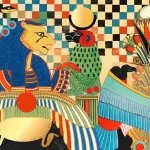Coptic Egypt: A Journey Through Time
Coptic Egypt is a term that refers to the period of Egyptian history when Christianity was the dominant religion in the region. The term “Coptic” comes from the Greek word for “Egyptian,” and it is used to describe the indigenous Christians of Egypt who have their own distinct traditions and culture.
The Coptic period of Egyptian
The Coptic period of Egyptian history dates back to the early years of Christianity, when Egypt was an important center of Christian thought and learning. The Copts have a rich and complex history, one that spans over two thousand years and has left an indelible mark on Egyptian culture and society.
The most enduring legacies of Coptic Egypt
One of the most enduring legacies of Coptic Egypt is its art and architecture. The Copts were known for their beautiful and intricate religious art, which included iconography, murals, and textiles. Many of these works of art can still be seen today in the numerous Coptic churches and monasteries that dot the Egyptian landscape.
Another important aspect of Coptic Egypt is its language. The Coptic language is a descendant of the ancient Egyptian language and was used as the primary written language in Egypt until the Islamic conquest in the 7th century. Today, the Coptic language is still used in the liturgy of the Coptic Orthodox Church and is taught in Coptic schools and seminaries.
The Copts also have a rich tradition of music, which is an important part of their religious services. Coptic music is known for its haunting melodies and intricate harmonies, and it has influenced many other musical traditions throughout the world.
Despite their long and rich history, the Copts have faced numerous challenges and struggles over the centuries. From persecution under the Roman Empire to more recent tensions with the Muslim majority in Egypt, the Copts have often been marginalized and discriminated against.
Despite these challenges, the Copts have remained a resilient and vibrant community, and their influence can be seen throughout Egyptian society. Today, the Copts make up approximately 10% of Egypt’s population, and their churches and monasteries continue to be important centers of religious and cultural life.
The Coptic period of Egypt’s history
The Coptic period of Egypt’s history began in the first century AD and lasted until the Arab conquest of Egypt in the 7th century. During this time, Egypt became a center of Christian thought and learning, and many of the most important early Christian theologians and thinkers were from Egypt.
One of the most important figures in the history of Coptic Egypt is Saint Anthony, who is known as the “Father of Monasticism.” Saint Anthony was a Christian ascetic who lived in the Egyptian desert in the 3rd and 4th centuries, and his teachings and writings have had a profound influence on the Coptic Orthodox Church and on Christian monasticism in general.
Another important figure in the history of Coptic Egypt is Saint Shenouda the Archimandrite, who lived in the 4th century and is known for his defense of orthodox Christian doctrine against heresy. Saint Shenouda is also known for his many writings on a wide range of subjects, including theology, philosophy, and monasticism.
Look here:Tips for Tourists in Egypt: Cultural Etiquette and Safety Advice
The Coptic Orthodox Church
The Coptic Orthodox Church is the largest Christian denomination in Egypt, and it is one of the oldest Christian churches in the world. The Coptic Orthodox Church has its own distinct liturgy and traditions, and its members are known for their piety and devotion.
Coptic art is known for its intricate designs and rich symbolism, and it is characterized by its use of bright colors and bold patterns. Coptic art includes a wide range of media, including textiles, manuscripts, ceramics, and jewelry.
Coptic Egypt has faced many challenges over the centuries, including persecution under the Roman Empire and more recent tensions with the Muslim majority in Egypt. Despite these challenges, the Copts have remained a resilient and vibrant community, and their influence can be seen throughout Egyptian society.
Coptic Egypt is not just a period of Egyptian history, but also refers to the Coptic Orthodox Church and its followers in modern-day Egypt. The Coptic Orthodox Church is one of the oldest churches in the world, and it traces its roots back to Saint Mark the Evangelist, who is said to have brought Christianity to Egypt in the first century.
The Coptic Orthodox Church has its own unique traditions and practices, including distinctive liturgy, fasting periods, and feast days. The Coptic calendar, which is based on the ancient Egyptian calendar, is also used by the church and is one of the oldest calendars in the world.
Coptic Egypt is also known for its impressive monasteries, which are some of the oldest in the world. The monasteries were built in remote locations, such as the desert, in order to provide a place for monks to live in solitude and contemplation. Some of the most famous Coptic monasteries include the Monastery of Saint Anthony, the Monastery of Saint Paul, and the Monastery of Saint Macarius the Great.
Coptic art is known for its intricate designs and bright colors, and it often features Christian symbols and motifs. One of the most famous examples of Coptic art is the Fayum portraits, which are a collection of realistic portraits painted on wooden boards that date back to the Roman period.
Look here: Handicraft markets and bazaars in Egypt
The Coptic language
The Coptic language, which is closely related to ancient Egyptian, is still used by the Coptic Orthodox Church in its liturgy and prayers. The Coptic language has also had a significant influence on Arabic, the language spoken in modern-day Egypt.
In modern times, the Copts have faced various challenges, including discrimination and persecution. However, the Coptic Orthodox Church and its followers remain an integral part of Egyptian society, and the Coptic culture and heritage continue to be celebrated and preserved.
In conclusion
Coptic Egypt is not only a fascinating period of Egyptian history, but also a living tradition that continues to influence and shape modern-day Egypt. From its ancient roots to its impressive monasteries and rich artistic traditions, the legacy of Coptic Egypt is a testament to the enduring power of faith and culture.








